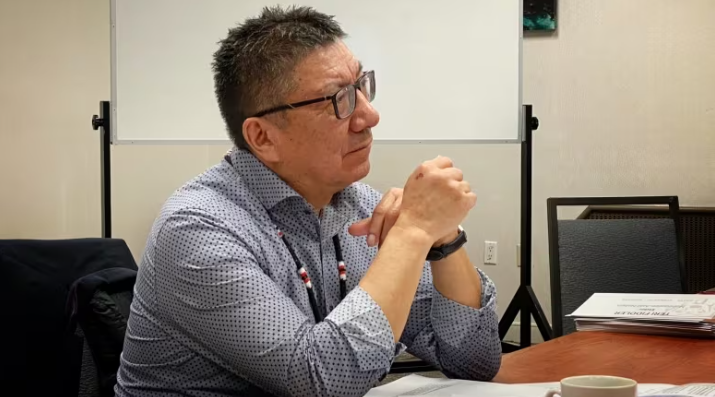Nishnawbe Aski Nation holds emergency meeting in Ottawa amid surge in sudden deaths on First Nations

First Nations chiefs from Ontario, federal officials at meeting after string of suicides, unexplained deaths
Leadership with the Nishnawbe Aski Nation (NAN) held an emergency meeting with federal officials after a string of recent youth suicides and unexplained deaths in First Nations across northwestern Ontario.
On Wednesday in Ottawa, the meeting to discuss the crisis and look at solutions included members of NAN’s executive committee, chiefs from northern Ontario and health experts, and Indigenous Services Minister Patty Hajdu. Assembly of First Nations (AFN) Grand Chief Cindy Woodhouse and Ontario Regional Chief Glen Hare were there as well.
Listing 13 recent deaths, including the suicide of a 12-year-old, NAN Grand Chief Alvin Fiddler said the sheer magnitude of the crisis has overwhelmed the communities’ capacities to respond and support their members.
“Our people are suffering, and more may be lost needlessly unless we take meaningful, collective action on an expedited basis,” said Fiddler in a statement.
In the past two months, communities have dealt with a number of sudden deaths, including:
- The 12-year-old’s suicide at Sachigo Lake First Nation on Jan. 15.
- Suicide of a 20-year-old at Deer Lake First Nation in January.
- Nine deaths in Kitchenuhmaykoosib Inninuwug First Nation between December 2023 and January 2024.
- Mackenzie Moonias, 14, from Neskantaga First Nation, whose body was found in Thunder Bay on Dec. 18.
- Jenna Ostberg, 21, from Bearskin Lake First Nation, who died in Thunder Bay on Dec. 30.
Kingfisher Lake First Nation, Sachigo Lake First Nation and Deer Lake First Nation have also had a disproportionately high number of suicides and suicide attempts, Fiddler said.
NAN represents 49 First Nations in Treaty 9 and Treaty 5 in northern Ontario, a land mass covering two-thirds of the province.
“It’s difficult being here today knowing that so many people back in my community are thinking about suicide,” said Kashechewan First Nation Chief Gaius Wesley, “As chief, I am a police officer, a counsellor, a drug enforcement officer and so much more.”
Federal support for affected nations was discussed at the meeting in Ottawa, said Hajdu, MP for Thunder Bay-Superior North.
The federal government has been working with NAN since 2017 through the Choose Life program, which fast-tracks funding proposals for child and youth mental health services that are focused on prevention, Hajdu said.
“But response is different than prevention,” she said. “I think that program has been essential in helping many, many children, but obviously something’s not working in that some children are not getting the relief that the promise of that program offers.”
The program has received about $563 million in funding over the past several years, Hadju said.
“It’s important that at some point we get to hear from youth themselves about what’s working well and what’s not working well about Choose Life. and whether or not there’s other elements of support that are needed.”

It will take more than mental health supports to fix the suicide crisis on First Nations, said Sol Mamakwa, the NDP MPP for Kiiwetinoong, which includes the region’s remote fly-in communities.
Mamakwa said he has attended many funerals in communities in his riding, including one recently for an 11-year-old girl in his home community of Kingfisher Lake First Nation.
Social determinants of health — such as housing, environment, education and socioeconomic factors — all play a role in mental health. Many youth living on First Nations without access to drinkable water, safe housing and adequate schools understandably experience depression as a result of their conditions, he said.

“How come we don’t have high schools in all the First Nations? How come we don’t have proper hospitals?” Mamakwa said. “When you’re underfunded and do not provide those resources to have clean drinking water, for example, that has an impact on your mental wellness.”
Many of the support services for youth are located farther away in urban centres, which means they either go without or have to board a plane for care, Mamakwa said. Each First Nation experiencing a suicide crisis needs to have services closer to home, he said.
“It’s so important that we come up with some type of strategy or process where we start creating a First-Nation-led wellness plan for each [community] because they’re the ones that know what needs to be done,” Mamakwa said.
“We just need to provide the support and the resources … rather than having a big facility out in Thunder Bay or wherever.”
While Mamakwa said a previous NAN emergency declaration in 2016 yielded provincial funding that had a tangible impact on the communities, he’s not holding out for any provincial help this time.
Provincial ministers from Ontario were absent from Wednesday’s emergency meeting, something both Mamakwa and Hadju criticized, and Fiddler noted on X, formerly Twitter.
“It’s business as usual while our communities, our nations are burying their people,” Mamakwa said.
Related News
Congress ups pressure to release boat strike video with threat to Hegseth’s travel budget
Stefani Reynolds/Bloomberg via Getty Images US lawmakers are trying to pressure the Trump administration toRead more
2 U.S. fighter jets fly over Gulf of Venezuela as lawmakers demand answers on boat strikes
The world’s largest aircraft carrier, the USS Gerald R. Ford, arrived in St. Thomas, U.S.Read more
